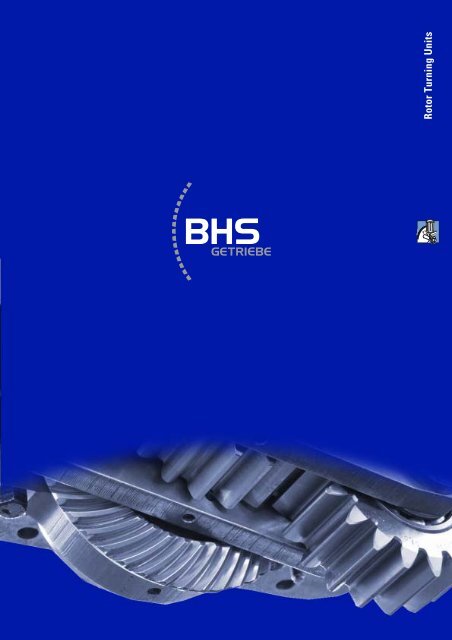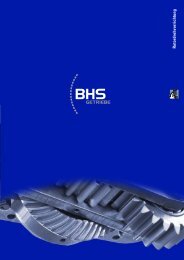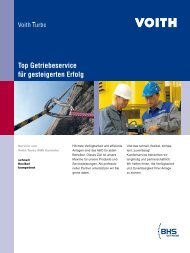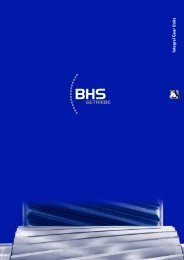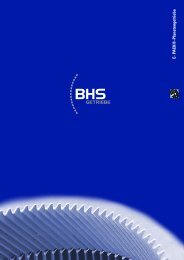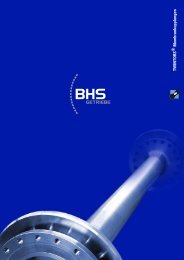Rotor Turning Units - BHS Getriebe GmbH
Rotor Turning Units - BHS Getriebe GmbH
Rotor Turning Units - BHS Getriebe GmbH
You also want an ePaper? Increase the reach of your titles
YUMPU automatically turns print PDFs into web optimized ePapers that Google loves.
<strong>Rotor</strong> <strong>Turning</strong> <strong>Units</strong>
<strong>BHS</strong><br />
<strong>Rotor</strong> <strong>Turning</strong> <strong>Units</strong><br />
Applications<br />
<strong>BHS</strong> <strong>Rotor</strong> <strong>Turning</strong> <strong>Units</strong> are well<br />
suited for the following appIications:<br />
Break-away and start up<br />
systems for shaft trains<br />
Very often the starting torque of the<br />
prime mover is insufficient to initiate<br />
rotation of the shaft trains. The use of<br />
a rotor turning device eliminates the<br />
need for hydrostatic bearings.<br />
The peak current required for normal<br />
start up can be greatly reduced.<br />
Low speed turning of <strong>Rotor</strong>s<br />
Continuous rotation of the rotors at<br />
low speeds avoids rotor deformation<br />
during the cooling down phase.<br />
Prevents fouIing and deposits of<br />
particulate matter in the blade<br />
channels<br />
Unless continuously rotated after<br />
shutdown, the rotors of expansion<br />
turbines and compressors working<br />
with impure gases may become<br />
unevenly coated with deposits. These<br />
deposits may increase the unbaIance<br />
IeveIs and/or the rotor may become<br />
bound to the stator.<br />
AIignment and positioning units<br />
for large shaft trains<br />
<strong>Turning</strong> units allow shaft trains to<br />
be slowly rotated in order to record<br />
radial and axial values for runout and<br />
to facilitate the connection of shafts<br />
and couplings.<br />
Figure 1:<br />
<strong>BHS</strong><br />
<strong>Rotor</strong> <strong>Turning</strong><br />
Unit,<br />
Type RDV 1.<br />
Figure 2:<br />
<strong>BHS</strong><br />
H-Series Gear<br />
with an<br />
attached <strong>Rotor</strong><br />
<strong>Turning</strong> Unit,<br />
Type RDV 60.<br />
2
Arrangements and Functionalities<br />
In Shaft Train Configuration<br />
Operation<br />
For shaft trains without a free shaft<br />
end, the <strong>Rotor</strong> <strong>Turning</strong> Unit has to be<br />
integrated into the shaft train, This is<br />
done by mounting the turning unit<br />
on a bearing housing or coupling<br />
guard, which is also recommended<br />
for <strong>BHS</strong> Epicyclic Gears.<br />
<strong>Rotor</strong> <strong>Turning</strong> <strong>Units</strong>, type RDV 1<br />
through RDV 5, operate based upon<br />
the swiveling pinion principle.<br />
During start up, the swiveling pinion<br />
drives a gear rim in the shaft train.<br />
Once the shaft train is under its own<br />
power, the swiveling pinion is<br />
pushed out of the mesh with the<br />
external gear rim. The pinion is secured<br />
in the disengaged position.<br />
Shaft End Mounting Configuration<br />
Operation<br />
For shaft trains with a free shaft end,<br />
completely automatic <strong>BHS</strong> <strong>Rotor</strong><br />
<strong>Turning</strong> <strong>Units</strong>, type RDV 60 through<br />
RDV 150, are available.<br />
On <strong>BHS</strong> Parallel Shaft Gear <strong>Units</strong>, the<br />
<strong>Rotor</strong> <strong>Turning</strong> Drive can be mounted<br />
on the free end of the pinion shaft.<br />
The turning unit drives the shaft<br />
train through an over running clutch,<br />
which disengages automatically<br />
once the drive train is operating.<br />
<strong>Turning</strong> drives on reversing shaft<br />
trains must be equipped with a sprag<br />
clutch or motor retaining brake to<br />
prevent engagement of the cIutch<br />
when operating in reverse.<br />
Features<br />
Installation on a horizontal mounting<br />
flange, above the gear rim.<br />
Easy installation and removal<br />
without complicated alignment.<br />
Various turning unit Options are<br />
available, ref. page 4.<br />
<strong>Units</strong> feature bevel gears, which<br />
use smaller drive motors than<br />
worm gear designs.<br />
Simple and robust construction,<br />
using standardilzed components.<br />
Thermal growth of the shaft train<br />
is unlimited.<br />
Equipped with handwheel and<br />
hexagon drive.<br />
Various explosion-proof systems<br />
of electric protection available.<br />
In-house testing available.<br />
Features<br />
Fully automatic, self-shifting<br />
clutch eliminates need for checking<br />
the shifting condition<br />
<strong>Units</strong> feature bevel gears, which<br />
use smaller drive motors than<br />
worm gear designs.<br />
<strong>Turning</strong> units made from<br />
standard components. Spare parts<br />
are available on short notice.<br />
Low weiglnt output range<br />
minimizes impact on shaft line<br />
rotor dynamics, thus making it<br />
suitable for maximum speeds.<br />
Equipped with handwheel and<br />
hexagon drive.<br />
Various explosion-proof systems<br />
of electric protection available.<br />
<strong>BHS</strong><br />
<strong>Rotor</strong> <strong>Turning</strong> <strong>Units</strong><br />
Typ RDV 1 - 5<br />
Swiveling Pinion<br />
Break-away torque:<br />
300 - 100000 Nm<br />
<strong>Turning</strong> speed:<br />
20 - 400 rpm<br />
<strong>Units</strong> driven<br />
by electric or<br />
hydraulic motor<br />
<strong>BHS</strong><br />
<strong>Rotor</strong> <strong>Turning</strong> <strong>Units</strong><br />
RDV 60 -150<br />
Overrunning CIutch<br />
Break-away torque:<br />
300 - 25 000 Nm<br />
<strong>Turning</strong> speed:<br />
3 - 300 rpm<br />
<strong>Units</strong> driven<br />
by electric or<br />
hydraulic motor<br />
3
Optional Features<br />
Swiveling Pin on <strong>Turning</strong> <strong>Units</strong><br />
Standard<br />
The turning device is manually engaged<br />
with the shaft train at standstill.<br />
A limit switch releases the drive<br />
motor, allowing the shaft train to<br />
turn. During acceleration of the shaft<br />
train, the swiveling pinion disengages<br />
automatically and is secured<br />
in a disengaged position.<br />
A limit switch for safety locking of<br />
the hand-wheel cover is provided.<br />
Automatic I<br />
Automatic I<br />
Swiveling Pinion <strong>Turning</strong> <strong>Units</strong><br />
In addition to the functions offered<br />
by the standard version, the „Automatic<br />
I“ system allows a remote<br />
controlled engagement by means<br />
of an installed hoisting magnet or<br />
pneumatic cylinder while the shaft<br />
train is at a standstill.<br />
Figure 3: Features of <strong>BHS</strong> <strong>Rotor</strong> <strong>Turning</strong> <strong>Units</strong><br />
Shaft End <strong>Turning</strong> <strong>Units</strong><br />
Standard<br />
The standard <strong>BHS</strong> <strong>Turning</strong> Unit is<br />
equipped with a self-synchronizing<br />
overrunning clutch. A limit switch<br />
for safety locking of the hand-wheel<br />
cover is provided.<br />
Options<br />
Available accessories:<br />
Motor retaining brake<br />
Sprag clutch<br />
Automatic II<br />
In addition to the functions offered<br />
by the „Automatic I“ system,<br />
„Automatic II“ allows the turning<br />
unit to synchronize with the shaft<br />
train while the shaft train is decelerating.<br />
The supplied control module<br />
assures automatic operation. Speed<br />
sensors on the shaft train release a<br />
command for the start and stop of<br />
the turning unit motor within a specific<br />
speed range. Speed sensors on<br />
the swiveling pinion allow smooth<br />
and controlled synchronization.<br />
Automatic II<br />
Swiveling Pinion & Shaft End <strong>Turning</strong> <strong>Units</strong><br />
Motor control center<br />
Position sensor for coupling<br />
engagement status.<br />
4
Rating<br />
Selection of the appropriate rotor turning unit is<br />
based upon the shaft train break-away torque. The<br />
type and power of the turning unit required are determined<br />
by means of diagrams 1 and 2.<br />
For swiveling pinion turning units, the size of the<br />
shaft train gear rim depends upon the space constraints<br />
of the appIication. The connection<br />
between the externaI gear rim diameter and the H<br />
dimensions can be determined from diagram 3.<br />
<strong>BHS</strong>-C<br />
RDV Typ<br />
dOS (mm)<br />
Module<br />
(rom)<br />
RDV 1 100 4<br />
RDV 2 120 5<br />
RDV 3 156 6<br />
RDV 4 180 6<br />
RDV 5 Upon request<br />
The external gear rim is made<br />
per customer requirements.<br />
Tabelle 1<br />
Diagram 2: Rating diagram,<br />
Swiveling Pinion <strong>Turning</strong> Unit, Type 1-5.<br />
Diagram 1: Selection diagram,<br />
Shaft End Tuming Unit, Type 60 -150.<br />
Diagmm 3: Selection diagram, Dimensions H depend<br />
upon the pitch circle diameter of external ring gear.<br />
5
Formula Designations:<br />
d OS [mm] Swiveling pinion pitch diameter<br />
(RDV 1 - 5, table 1)<br />
d OW [mm] External gear rim pitch diameter<br />
(RDV 1 - 5, diagram 3)<br />
J [kgm 2] Mass moment of inertia<br />
of the shait train (m 2)<br />
M S [Nm] Break-away torque at the swiveling<br />
pinion (RDV 1 - 5, diagram 2)<br />
M TL [Nm] Break-away torque required at the shaft<br />
Attention: For shaft trains with hydrostatic<br />
bearings use double the values of M TL<br />
obtained from diagram 1 or diagram 2<br />
N [1] Acceleration factor<br />
n S [rpm] Swiveling pinion shaft speed<br />
(RDV 1 - 5, diagram 2)<br />
n T [rpm] <strong>Turning</strong> speed of the shaft train<br />
P [kW] ElectricaI power<br />
t [sec] AcceIeration time<br />
Once the suitable turning unit has been selected, the<br />
application must be analyzed to determine whether the<br />
shaft train can be accelerated to the turning speed without<br />
overheating the motor:<br />
t=0,12 • (J/M TL) • (n T/N+30/N 4 )<br />
MTL resp. MS (existing for P)<br />
N =<br />
MTL resp. MS (required)<br />
approximate vaIue: t _< 12 sec.<br />
6
Dimensions<br />
Swivleling Pinion Tuning Unit<br />
Type RDV 1 - 5<br />
Table 2<br />
Figure 5: <strong>BHS</strong> <strong>Rotor</strong> <strong>Turning</strong> Unit<br />
on the test stand especiaffy<br />
set up for this application.<br />
Figure 6: <strong>BHS</strong> <strong>Rotor</strong> <strong>Turning</strong> Unit<br />
Control Module. The photograph<br />
shows the turning speed circuit board.<br />
7
Examples:<br />
Swiveling Pinion <strong>Turning</strong> Unit<br />
Required d OW = 400 mm<br />
Required M TL = 2200 Nm<br />
(calculated with a friction factor of 0,2)<br />
Desired n T = 65 rpm<br />
Mass moment of inertia = 1600 kgm 2<br />
M S = M TL • d OS/d OW<br />
Assumption RDV 1, d OS<br />
= 100 mm<br />
M S = 2200 • 100/400 = 550 Nm<br />
n S = n T • d OW/d OS<br />
n S = 65 • 400/100 = 260 rpm<br />
-» ref. diagram 2: RDV 1 with P = 7,5 kW<br />
-» ref. diagram 3: Dimension H = 270 mm<br />
Shaft End <strong>Turning</strong> Unit<br />
Required M TL = 2200 Nm<br />
(calculated with a friction factor of 0,2)<br />
Desired n T = 65 rpm<br />
Mass moment of inertia = 1600 kgm 2<br />
-» ref. diagram 1: RDV 80 with P = 7,5 kW<br />
Acceleration time:<br />
t = 0,12 • (1600/2200) • (65/1,091 + 30/N 4 )<br />
N = 600/550 = 1,091<br />
t = 0,087 • (59,578 + 21,175) = 7 sec.<br />
-» <strong>Turning</strong> drive sufficiently dimensioned.<br />
8
Dimensions<br />
Shaft End Mounted <strong>Turning</strong> Unit<br />
Type RDV 60 - 150<br />
Table 2<br />
Figure 8: <strong>BHS</strong> RDV 90<br />
without adapter casing.<br />
Let <strong>BHS</strong> review your<br />
turning drive and<br />
recommend a solution.<br />
To enable us to provide a complete<br />
quotation, please furnish the following<br />
information:<br />
Break-away torque<br />
<strong>Turning</strong> speed<br />
Mass moment of intertia<br />
ElectricaI requirements<br />
Installation arrangement.<br />
9
<strong>BHS</strong><br />
<strong>Getriebe</strong> <strong>GmbH</strong><br />
Hausanschrift:<br />
Hans-Böckler-Strasse 7<br />
87527 Sonthofen<br />
Germany<br />
Postanschrift:<br />
Postfach 1251<br />
87516 Sonthofen<br />
Germany<br />
fon +49 83 21 802 - 0<br />
fax +49 83 21 802 - 689<br />
www.bhs-getriebe.de<br />
info@bhs-getriebe.de<br />
<strong>BHS</strong><br />
<strong>Getriebe</strong> Inc.<br />
4357 Ferguson Drive<br />
Suite 280<br />
Cincinnati, Ohio 45245<br />
U.S.A.<br />
phone +1 513 797 - 8100<br />
fax +1 513 797 - 8103<br />
www.bhs-gears.com


